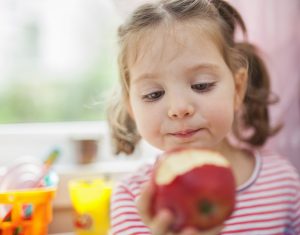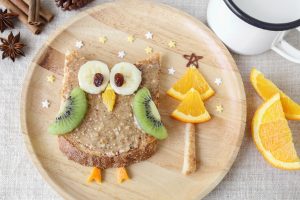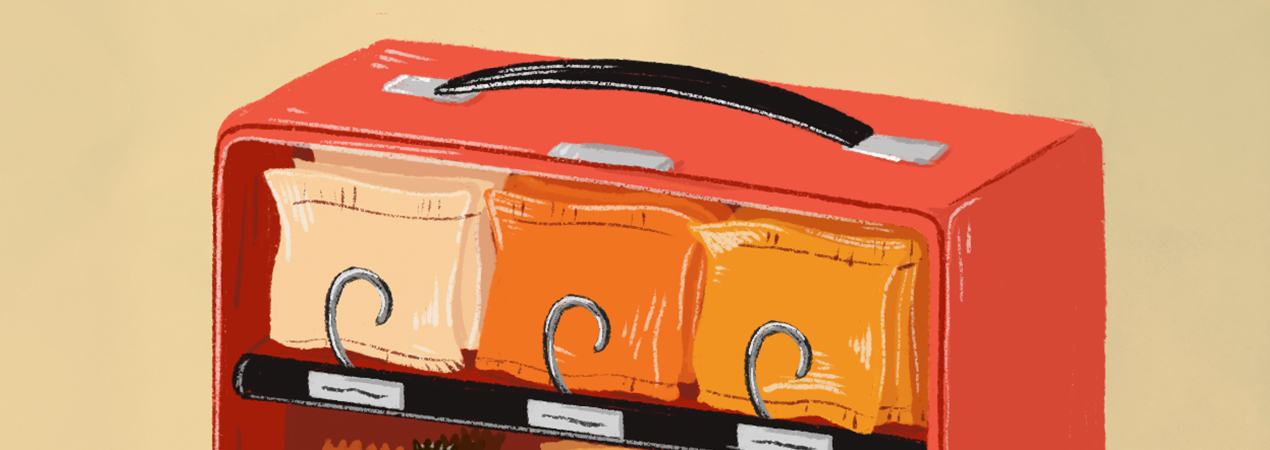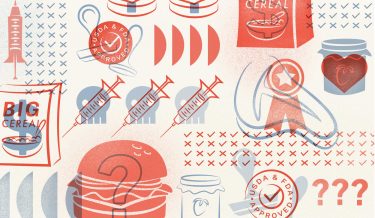Children may well be the princes and princesses of snacking, and for good reason – according to the USDA’s Choosemyplate.gov, kids’ snacks “can help children get the nutrients needed to grow and maintain a healthy weight.”1 Whether it’s after school, at a play date or on a car ride that lasts more than five minutes, there will always be a need for snacks that satisfy little tummies.
The food purchase behavior of parents certainly validates this. As well as being among those more likely to snack themselves,* parents are 31 percent more likely than the general population to purchase food from a vending machine2 and 39 percent more likely to purchase it from places like retail stores or at the mall.2
In short, people with children need food on the move. With kids back at school, and parents stocking the house with snacks, we were inspired to look at what defines the perfect kid’s snack. Three things prevailed: health, convenience and novelty, all of which have their own roles to play in a child’s diet. We also took a look at the grocery store shelves to round up which kids’ snack products are striking the balance between what kids want and what parents need.
1. Parents Want Healthy Snacks; Kids Want Tasty Ones
 While health isn’t always Mom and Dad’s top priority for themselves (less than half admit that they are firmly committed to a healthy diet2), it certainly is for their kiddos.
While health isn’t always Mom and Dad’s top priority for themselves (less than half admit that they are firmly committed to a healthy diet2), it certainly is for their kiddos.
“[I go for] easy and healthy ALWAYS for everything.”
–Rachel, mother of a 3-year-old and a 4-month-old.
The USDA recommends that kids snack on whole grains, protein and fruits, among other things. Parents tend to follow suit, purchasing protein-rich snacks such as string cheese, meat sticks and peanut butter in droves.
Meat snack brand “The New Primal” ticks a lot of boxes with its brilliantly kid-focused “Snack Mates” range. These free-range or grass-fed meat sticks are beautifully designed for children and ensure they get 12 percent of their recommended daily amount of protein. They are also certified paleo, gluten-free and hormone-, GMO- and antibiotic-free and allergen friendly to boot, so even the most specific of kid diets is catered to.
Taking traditional peanut butter in a new direction is “Little Nut”, for children six months and older. Created as a “healthy on-the-go protein source that is also an easy way to introduce peanuts to little ones,” Little Nut’s squeeze packs contain a blend of peanuts, coconut and fruit. They also feature a packaging design that will put a smile on the faces of both children and parents.
The energy bar market is a hive of activity. The U.S. market alone is worth more than $3 billion and part of its growth is attributed to rising clean-label claims.3 These bars often boast short ingredient lists and long free-from lists. This transparency (not to mention their indulgent flavor profiles like peanut butter cookies and chocolate chip cookie dough) helps position them as a healthy, while incredibly tasty, kids’ snack option. It’s not surprising then that a lot of the key players in this arena have created kid-friendly versions. RXBAR Kids™, Clif Kids Zbars® LÄRABAR Kid™ are all smaller or more portion-controlled versions of their popular adult counterparts.
2. Convenient Kids’ Snacks Rule
 Second only to health is convenience. If a kid’s snack can’t be easily pulled from the fridge, the glovebox or a pocket and devoured with little to no prep, it is unlikely to make the grade.
Second only to health is convenience. If a kid’s snack can’t be easily pulled from the fridge, the glovebox or a pocket and devoured with little to no prep, it is unlikely to make the grade.
“When my 6yo starts demanding snacks, we have about 30 seconds to comply.”
–Christy, mother of a 6-year-old
Equally as important is self-sufficiency. There is no time for packaging admin when hunger strikes a hangry independent grade schooler. Kids and parents both get frustrated if the child can’t easily open, unwrap or build their snack by themselves.
“As she gets older, it’s important that we have snacks she can get out and open herself. It frustrates her when she has to ask us for help opening something.”
Luckily, this is not a new problem and it is one very well-catered to. Many leading brands’ easy-to-use packaging is almost as iconic as their products. Take Mini Babybel®, an icon of Bel’s for 40 years, for example: easy-to-peel rind that comes off smoothly to reveal a satisfyingly perfect round of cheese, and no wrappers or cartons in sight (plus every kid knows that the waxy rind doubles a cool red crayon).
Perhaps even more iconic are yogurt tubes, made famous by Yoplait’s first-to-market Go-Gurt® brand. The simple move from plastic cup to squeeze-tube meant yogurt was no longer something that had to be eaten at a table with a spoon with a ton of baby wipes on hand. Kids loved the independence and the novelty that came with these easy-to-open tubes and probably the odd sensation that came with squirting food directly into their mouths.
3. Novelty Snacks are All-Powerful

Parenting blogs and publications are awash with recipes and suggestions to make healthy kids’ snacks that they will be excited about. Because let’s face it, sometimes the strive for health and convenience is all well and good (apples and bananas are both healthy and easy, but they don’t always cut it with demanding toddlers), but children are tough critics and if they don’t want to eat something, they probably won’t.
“[It has to be] something that doesn’t take convincing – desirable.”
–Parc, father of a 7-year-old and a 5-year-old
This is where packaging design has a slightly different purpose than it does for us more mature consumers, and can be the savior of a meltdown in the aisles. If a child has chosen a snack themselves, then they’re more likely to eat it.
Licensed characters have incredible power here, but provide CPG brands and their packaging designers with a fine line to walk. The power that licensed characters have over children needs to be applied very carefully. Characters have the power to promote pretty much whatever choices brands want them to (and whatever brands want parents to spend), however unhealthy, and as a result, their usage has been debated for years. However, when used responsibly, they also have the power to promote healthy choices.
Three fantastic examples of this come from Crunch Pak®, Chobani® and Dole®.
Crunch Pak’s Paw Patrol protein-rich snack trays are shaped like the puppy-paws of one of the most successful licenses of recent years, and their Disney Foodles snack packs are shaped like the ears of the world’s most famous mouse. Instantly recognizable and containing a healthy balanced snack, these will please consumers of all ages.
In 2016, Disney and Dole announced a long-term partnership4 set to combine Dole fresh produce with Disney characters, but according to Business Insider, “The partnership won’t just involve putting Elsa’s picture on an orange or slapping Yoda’s wizened mug on some broccoli.”5 It goes beyond that to a higher educational purpose, featuring “digital interactions, in-store activities, and themed recipes.”3 – all designed “to deliver fun, educational and nutritional information around the power of produce to individuals and families across North America.”4
Above All, Parents Strive for Balance
While kids might be satisfied eating anything with a character on the wrapper, parents are rarely looking for just one thing from a kid’s snack. Yes, a time and place might dictate what they need in that precise moment, but when they are filling their shopping cart with their children in mind, what they need is variety.
“I just try to go for balance.”
–Ann, mother of a 3-year-old and a 10-month-old.
When developing products that need to serve both parents and children, a good rule of thumb is to aim for two out of three: healthy, convenience and novelty. Any combination of these will serve a consumer much more than just one alone will.
But the most important lesson, and the thing parents will be most grateful for, is to use the novelty factor wisely. CPG brands have the power to get children to sample foods that parents can’t always get them to try by themselves. But many of us learned as kids from Spider-Man, that “with great power comes great responsibility.” They must be sure not to take advantage of stressed-out parents by positioning novelty- or character-led products as a short-term solution, knowing that they will ultimately be left feeling guilty in the long run. By balancing taste, convenience and novelty, parents, kids, CPGs and retailers can all win.
*Signal Theory FoodThink 2014 respondents who answered “Once a day or more” to the question “How often do you snack?”
Sources
1. United States Department of Agriculture.
2. Signal Theory FoodThink 2016.
3. Research & Markets “Global Energy Bar Market – Segmented by Distribution Channel and Geography – Growth, Trends, and Forecast (2018 – 2023).”
4. Produce Business, June 2017.
5. Business Insider, October 2016.
- Healthy Eating
Filed Under



